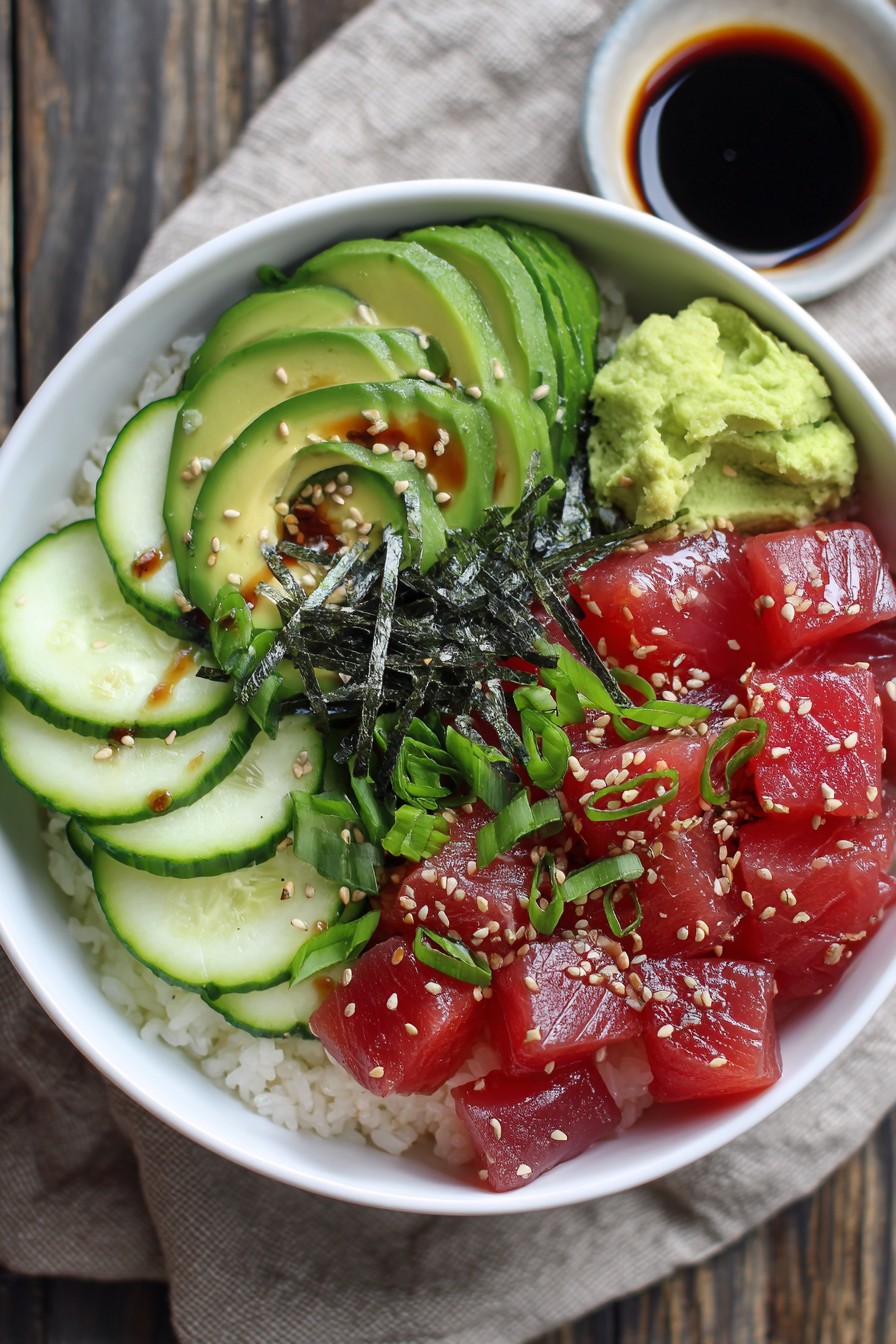Get ready to experience sushi in bowl form. This tuna sushi bowl delivers all the fresh flavors you love from traditional sushi without the rolling technique. Great for quick lunches or easy dinners when you want something satisfying yet simple to prepare.
Why This Recipe Works
- Uses pre-cooked rice to eliminate the most time-consuming step of traditional sushi preparation
- Fresh tuna provides high-quality protein without requiring cooking equipment or techniques
- Simple seasoning with rice vinegar and sugar creates authentic sushi rice flavor quickly
- Customizable toppings allow for personal preference and ingredient availability
- Bowl format makes assembly straightforward and eliminates the need for special rolling skills
Ingredients
- 3 cups cooked short-grain white rice, cooled to room temperature
- 8 ounces sushi-grade tuna, cut into 1/2-inch cubes
- 1/4 cup rice vinegar
- 2 tablespoons granulated sugar
- 1 teaspoon salt
- 1 medium avocado, sliced into 1/4-inch pieces
- 1 small cucumber, thinly sliced into rounds
- 2 sheets nori seaweed, cut into thin strips
- 2 tablespoons soy sauce
- 1 tablespoon sesame seeds
- 1 teaspoon wasabi paste
- 2 green onions, thinly sliced
- 1 tablespoon pickled ginger
Equipment Needed
- Medium mixing bowl
- Small saucepan
- Cutting board
- Sharp knife
- Measuring cups and spoons
- Rice paddle or wooden spoon
- Individual serving bowls
Instructions

Prepare the Sushi Rice Seasoning
Combine rice vinegar, sugar, and salt in a small saucepan over medium heat. Stir continuously with a wooden spoon until the sugar and salt completely dissolve, which typically takes 2-3 minutes. You’ll know the mixture is ready when no sugar granules remain visible and the liquid appears clear. Remove from heat immediately and let cool for 5 minutes until warm but not hot. This step is crucial because adding hot vinegar mixture to rice would make it mushy. The warm temperature helps the seasoning absorb evenly while maintaining proper rice texture. Tip: For best results, use a thermometer to ensure the mixture cools to between 100-110°F before adding to rice.
Season the Cooked Rice
Place cooled cooked rice in a medium mixing bowl. Drizzle the prepared vinegar mixture over the rice in a thin, steady stream while using a rice paddle or wooden spoon to fold and cut through the rice. Continue this folding motion for 2-3 minutes until all rice grains are evenly coated. The rice should glisten slightly and have a subtle vinegar aroma. Be careful not to smash the rice grains during mixing – use a slicing motion rather than stirring. The ideal sushi rice should be slightly sticky but still have distinct individual grains. Let the seasoned rice sit for 10 minutes to allow flavors to meld properly before assembling your bowls.
Prepare the Toppings
Cut sushi-grade tuna into uniform 1/2-inch cubes using a sharp knife on a clean cutting board. Slice avocado lengthwise, remove the pit, and make crosswise cuts through the flesh without cutting through the skin. Use a spoon to scoop out perfect avocado slices. Cut cucumber into thin rounds approximately 1/8-inch thick. Stack nori sheets and use kitchen shears to cut into thin strips about 1/4-inch wide. Thinly slice green onions, separating the white and green parts. Arrange all prepared ingredients in separate small bowls or sections of your cutting board for easy assembly. Tip: Keep tuna refrigerated until the last possible moment to maintain freshness and food safety.
Assemble the Bowls
Divide the seasoned sushi rice evenly between two serving bowls, creating a flat base layer. Arrange tuna cubes in a circular pattern over one section of the rice. Place avocado slices and cucumber rounds in separate sections around the tuna. Sprinkle nori strips over the entire bowl, focusing particularly on areas between other ingredients. Distribute sliced green onions evenly across the surface. The assembly should be visually appealing with distinct sections of colorful ingredients. Leave some rice visible between toppings to create contrast. This presentation method makes the bowl both beautiful and functional, allowing diners to mix ingredients to their preference.
Add Final Seasonings and Serve
Drizzle 1 tablespoon of soy sauce over each bowl in a zigzag pattern. Sprinkle 1/2 tablespoon of sesame seeds over each serving. Place 1/2 teaspoon of wasabi paste and 1/2 tablespoon of pickled ginger in small mounds on the side of each bowl. Serve immediately while all ingredients are at their peak freshness and temperature. The contrast between room temperature rice, cool vegetables, and chilled tuna creates the perfect eating experience. Tip: For optimal flavor, mix the wasabi directly into the soy sauce before dipping pieces of tuna, or mix everything together thoroughly for a unified flavor profile.
Tips and Tricks
When selecting sushi-grade tuna, look for bright red color with no brown spots and a firm texture. The flesh should spring back when pressed lightly. Always purchase from reputable fish markets that specialize in sushi-grade products and ask when the fish was delivered. For the rice, using day-old cooked rice actually works better than freshly cooked rice because it has less moisture content. If using freshly cooked rice, spread it on a baking sheet and let it cool completely before seasoning. This prevents the rice from becoming gummy when the vinegar mixture is added.
For perfect rice seasoning, consider making extra vinegar mixture and storing it in the refrigerator for up to two weeks. This allows you to quickly prepare sushi rice whenever the craving strikes. The ratio is always 1 part sugar to 2 parts rice vinegar with salt to taste. When cutting the tuna, use a very sharp knife and make clean, single-stroke cuts rather than sawing back and forth. This preserves the texture of the fish and creates cleaner edges. Chill your knife in the freezer for 10 minutes before cutting tuna for even cleaner slices.
If you cannot find sushi-grade tuna, you can use high-quality canned tuna packed in water. Drain it thoroughly and mix with 1 teaspoon of soy sauce and 1/2 teaspoon of sesame oil for enhanced flavor. For vegetarian options, substitute the tuna with cubed firm tofu that has been marinated in soy sauce and lightly pan-seared. When storing leftovers, keep components separate and consume within 24 hours for best quality. The rice will harden in the refrigerator, so bring it to room temperature before serving again.
For enhanced presentation, consider using Japanese-style bowls and chopsticks. You can also add a small dish of extra soy sauce and wasabi on the side for those who prefer stronger flavors. If making this recipe for guests, prepare all components ahead of time and assemble just before serving to maintain optimal texture and temperature contrasts. The key to excellent sushi bowls lies in the balance of temperatures, textures, and fresh ingredients.
Recipe Variations
- Spicy Tuna Version: Mix the cubed tuna with 2 tablespoons of mayonnaise and 1-2 teaspoons of sriracha sauce before assembling. Add a sprinkle of crushed red pepper flakes for extra heat. This variation adds creaminess and spice that complements the fresh flavors. You can adjust the spice level according to your preference by increasing or decreasing the sriracha amount.
- Vegetarian Option: Replace tuna with 1 cup of edamame beans and 1/2 cup of cubed baked tofu. Add 1/4 cup of shredded carrots for additional color and texture. The edamame provides protein while maintaining the bowl’s nutritional profile. Marinate the tofu in soy sauce and ginger before baking for enhanced flavor.
- Brown Rice Alternative: Substitute short-grain white rice with an equal amount of cooked short-grain brown rice. Increase the vinegar mixture by 50% as brown rice absorbs more liquid. This variation adds fiber and nutrients while maintaining the sushi bowl concept. The nutty flavor of brown rice pairs well with the other ingredients.
- California Roll Style: Use imitation crab instead of tuna and add 1/4 cup of mayonnaise mixed with 1 teaspoon of lemon juice. Include 2 tablespoons of masago (capelin roe) for authentic California roll flavor. This variation appeals to those who prefer cooked seafood over raw fish while maintaining the sushi experience.
- Deconstructed Spicy Tuna Roll: Use the spicy tuna variation above and add 1/4 cup of tempura crunchies (available in Asian markets) for texture. Include thin slices of jalapeño for additional heat and freshness. This variation recreates the popular spicy tuna roll in bowl form with all the characteristic flavors and textures.
Frequently Asked Questions
What does sushi-grade mean and is it safe to eat raw tuna?
Sushi-grade refers to fish that has been frozen at specific temperatures to kill potential parasites, making it safe for raw consumption. The FDA requires fish intended for raw consumption to be frozen at -4°F for 7 days or at -31°F for 15 hours. Reputable fish markets follow these guidelines. When purchasing sushi-grade tuna, look for bright color, firm texture, and fresh ocean smell. Always buy from trusted sources and consume within 24 hours of purchase for optimal safety and quality. Proper handling and refrigeration are essential for food safety.
Can I make this recipe with regular canned tuna?
Yes, you can substitute sushi-grade tuna with high-quality canned tuna packed in water. Drain the tuna thoroughly and consider mixing it with 1 teaspoon of soy sauce and 1/2 teaspoon of sesame oil for enhanced flavor. The texture will be different but still enjoyable. For best results, use solid white albacore tuna rather than chunk light tuna. This substitution makes the recipe more accessible and affordable while maintaining the general concept of a tuna sushi bowl. The canned version should be flaked rather than cubed during assembly.
How far in advance can I prepare the components?
You can prepare the seasoned rice up to 4 hours in advance if kept covered at room temperature. Do not refrigerate the rice as it becomes hard and loses texture. The vegetables can be prepped 2-3 hours ahead and stored in separate containers in the refrigerator. The tuna should be cut immediately before serving for food safety and optimal texture. Assembled bowls should be served within 30 minutes of preparation. For meal prep, keep all components separate and assemble just before eating to maintain quality and food safety standards.
What type of rice works best for sushi bowls?
Short-grain Japanese rice is ideal because it becomes slightly sticky when cooked, which helps the seasoning adhere and creates the authentic sushi rice texture. Medium-grain rice like Calrose can work as a substitute if Japanese rice is unavailable. Avoid long-grain rice like basmati or jasmine as they remain too separate and dry. The rice should be cooked with slightly less water than usual to achieve the proper firmness. Rinsing the rice before cooking removes excess starch and prevents mushiness. Proper rice preparation is fundamental to achieving authentic sushi bowl results.
Can I add other vegetables to this recipe?
Absolutely, this recipe is highly customizable. Common additions include shredded carrots, thinly sliced radishes, blanched asparagus, or edamame beans. For crunch, consider adding tempura flakes or crispy onions. Other popular options include corn kernels, microgreens, or shaved Brussels sprouts. The key is maintaining balance – include a variety of colors, textures, and flavors without overwhelming the primary components. Cut additional vegetables into bite-sized pieces that complement the existing ingredients. Experiment with different combinations to discover your personal preference while maintaining the essential sushi bowl concept.
Summary
This tuna sushi bowl combines seasoned rice, fresh tuna, and crisp vegetables for a deconstructed sushi experience. Simple preparation and customizable toppings make it accessible for home cooks. The recipe delivers authentic flavors without specialized techniques or equipment.



